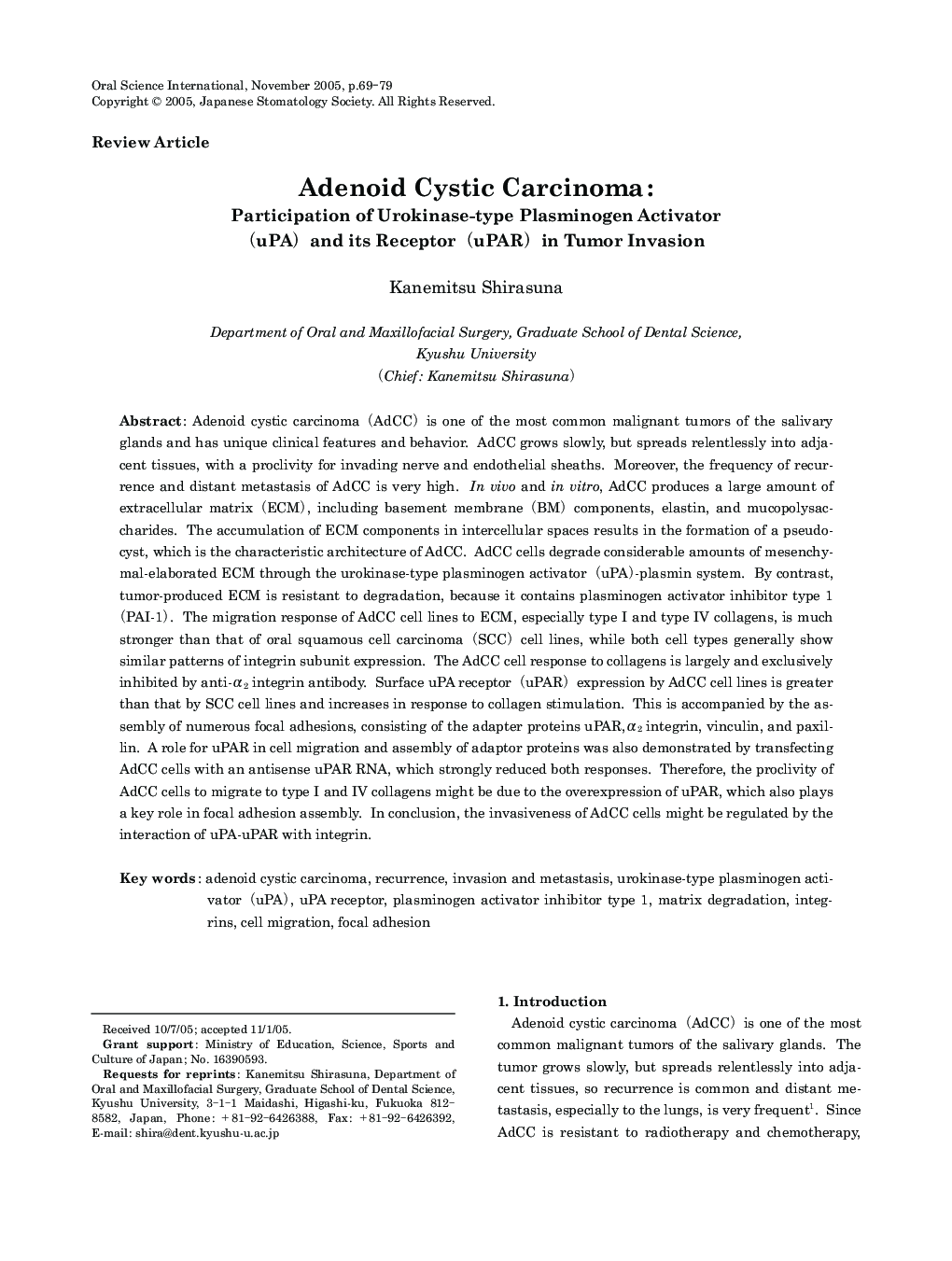| کد مقاله | کد نشریه | سال انتشار | مقاله انگلیسی | نسخه تمام متن |
|---|---|---|---|---|
| 9103448 | 1152707 | 2005 | 11 صفحه PDF | دانلود رایگان |
عنوان انگلیسی مقاله ISI
Adenoid Cystic Carcinoma
دانلود مقاله + سفارش ترجمه
دانلود مقاله ISI انگلیسی
رایگان برای ایرانیان
کلمات کلیدی
Urokinase-type plasminogen activator (uPA)Integrins - اینتگرینMatrix degradation - تخریب ماتریکسInvasion and metastasis - تهاجم و متاستازRecurrence - عودCell migration - مهاجرت سلولیPlasminogen activator inhibitor type 1 - نوع مهار کننده فعال کننده پلاسمینوژن 1Focal adhesion - چسبندگی کانونیAdenoid cystic carcinoma - کارسینوم آدنوئید کیستیکuPA receptor - گیرنده uPA
موضوعات مرتبط
علوم زیستی و بیوفناوری
بیوشیمی، ژنتیک و زیست شناسی مولکولی
بیوشیمی بالینی
پیش نمایش صفحه اول مقاله

چکیده انگلیسی
Adenoid cystic carcinoma (AdCC) is one of the most common malignant tumors of the salivary glands and has unique clinical features and behavior. AdCC grows slowly, but spreads relentlessly into adjacent tissues, with a proclivity for invading nerve and endothelial sheaths. Moreover, the frequency of recurrence and distant metastasis of AdCC is very high. In vivo and in vitro, AdCC produces a large amount of extracellular matrix (ECM), including basement membrane (BM) components, elastin, and mucopolysaccharides. The accumulation of ECM components in intercellular spaces results in the formation of a pseudocyst, which is the characteristic architecture of AdCC. AdCC cells degrade considerable amounts of mesenchymal-elaborated ECM through the urokinase-type plasminogen activator (uPA)-plasmin system. By contrast, tumor-produced ECM is resistant to degradation, because it contains plasminogen activator inhibitor type 1 (PAI-1). The migration response of AdCC cell lines to ECM, especially type I and type IV collagens, is much stronger than that of oral squamous cell carcinoma (SCC) cell lines, while both cell types generally show similar patterns of integrin subunit expression. The AdCC cell response to collagens is largely and exclusively inhibited by anti-α2 integrin antibody. Surface uPA receptor (uPAR) expression by AdCC cell lines is greater than that by SCC cell lines and increases in response to collagen stimulation. This is accompanied by the assembly of numerous focal adhesions, consisting of the adapter proteins uPAR,α2 integrin, vinculin, and paxillin. A role for uPAR in cell migration and assembly of adaptor proteins was also demonstrated by transfecting AdCC cells with an antisense uPAR RNA, which strongly reduced both responses. Therefore, the proclivity of AdCC cells to migrate to type I and IV collagens might be due to the overexpression of uPAR, which also plays a key role in focal adhesion assembly. In conclusion, the invasiveness of AdCC cells might be regulated by the interaction of uPA-uPAR with integrin.
ناشر
Database: Elsevier - ScienceDirect (ساینس دایرکت)
Journal: Oral Science International - Volume 2, Issue 2, November 2005, Pages 69-79
Journal: Oral Science International - Volume 2, Issue 2, November 2005, Pages 69-79
نویسندگان
Kanemitsu (Chief),